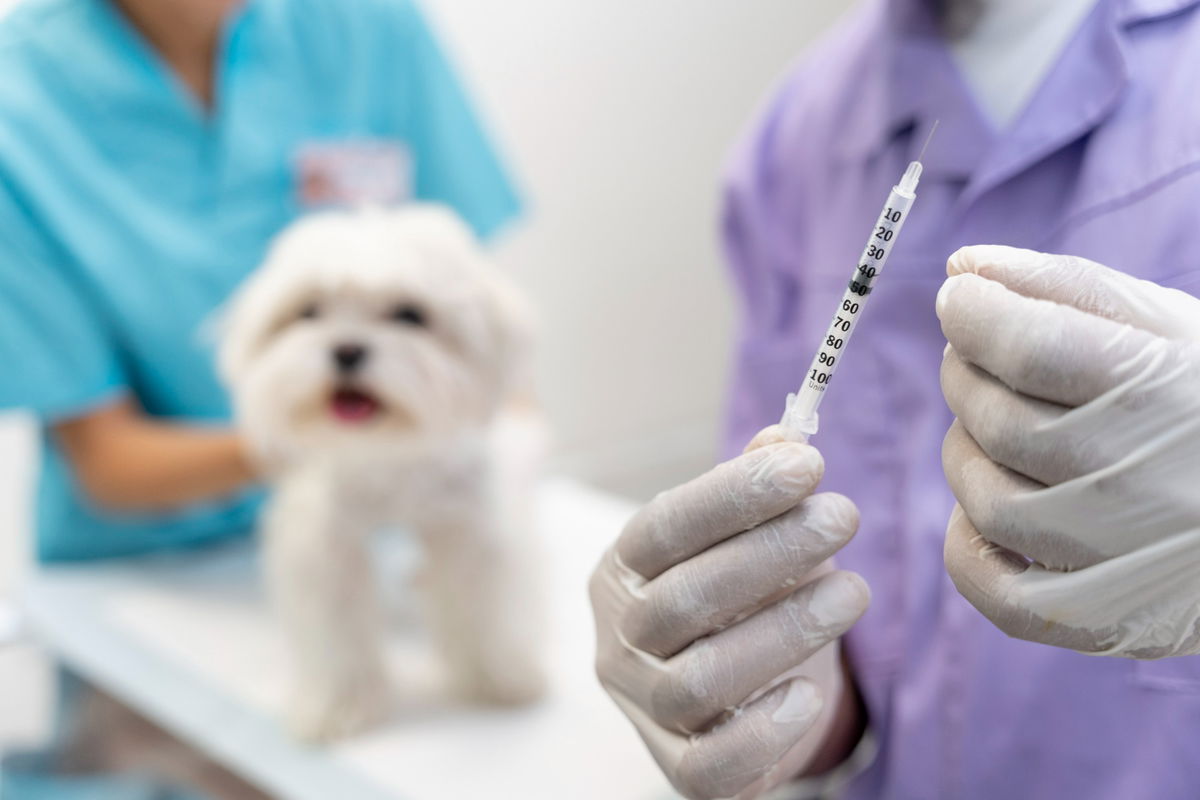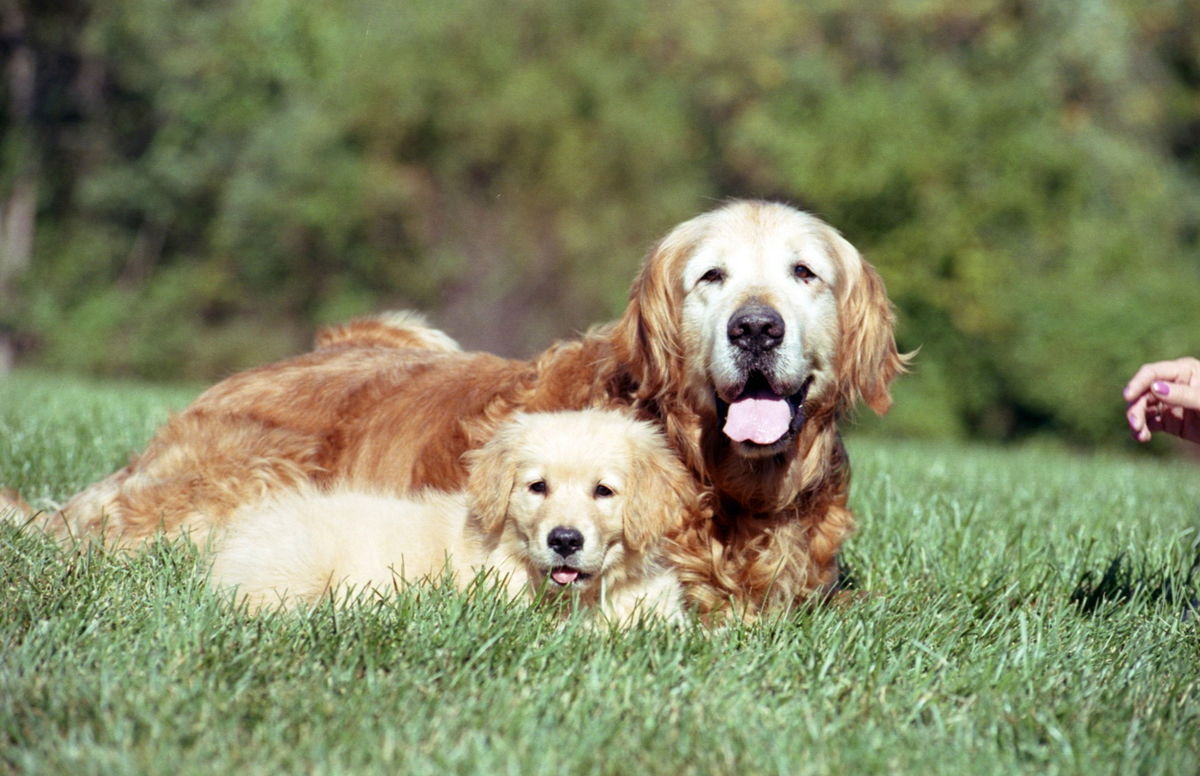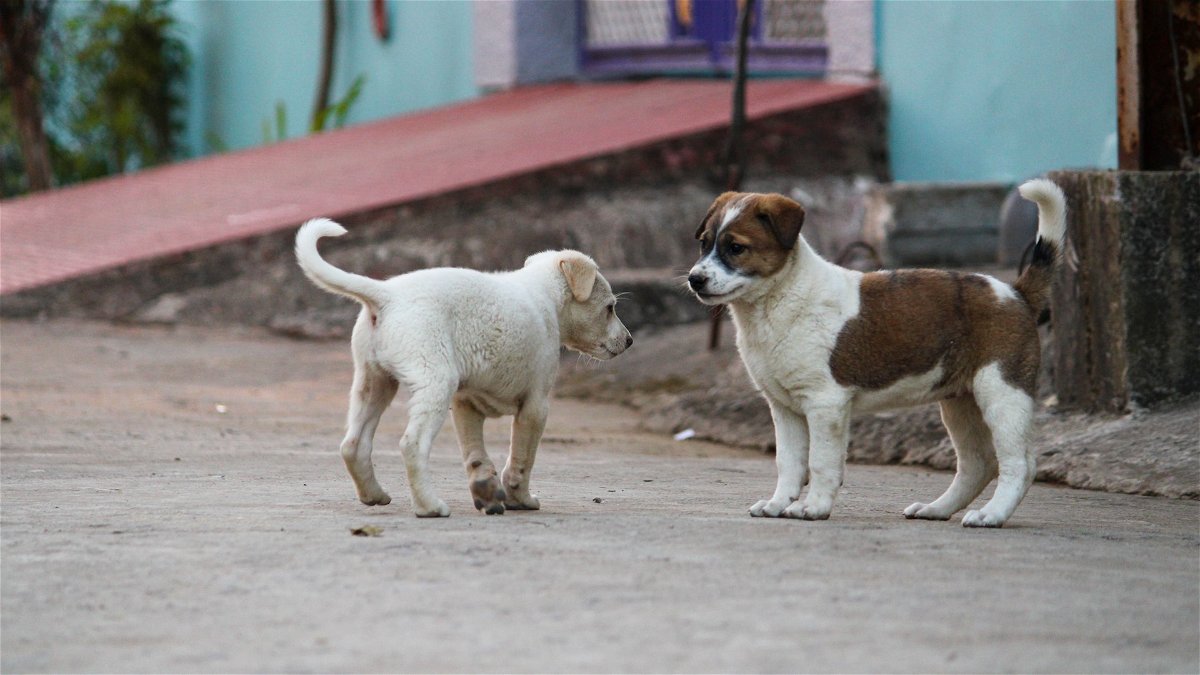We're an affiliate
We hope you love the products we recommend! Just so you know, we may collect a share of sales or other compensation from the links on this page at no additional cost to you. Thank you if you use our links, we really appreciate it!
In true puppy fashion, your new friend is going crazy cooped up in your house, but when can a puppy be around other dogs?
If you’re a new puppy owner it can be tricky deciding when and how to introduce your new puppy to the world.
Today you’ll receive lots of tips and tricks to get you started on your pet journey and take the guesswork out of the equation.
Understanding Your Puppy’s Age and Vaccination Status
You brought your new puppy home and you are so excited to get out and play with them but there are quite a few age considerations to be aware of before you start socializing your puppy.
Especially around other dogs who could potentially pass on diseases. If you got your puppy from a breeder, they are probably about 8 weeks old. This means that they haven’t finished their vaccinations.
Puppies are born with some immunity from their mother and they continue to receive this immunity while they nurse.
It is important to vaccinate your puppy. Eventually, they lose that natural immunity and are at risk of contracting diseases.
Until they lose their mom’s antibodies, vaccines don’t offer them much protection and are often not successful in boosting immunity until 16 weeks of age.
For this reason, puppies get a series of vaccinations. These protect them from many different types of diseases. While different countries may require different vaccine schedules, there are no doubt similarities.
Most vaccines break down into two categories:
- Core vaccines that are highly recommended for all puppies
- Non-core vaccines are optional and depend on your lifestyle.
| Vaccine | Category | Age to Administer | Booster shots |
| Distemper, adenovirus, parainfluenza, parvovirus (DAPP or DHPP) | Core | 6-8 weeks | – Every 2-4 weeks till 16 weeks – Every 1 year after the first dose – Every 3 years after 1-year dose |
| Rabies | Core | Illegal to not administer | – Depends on the law in your country |
| Bordetella | Non-Core | 9-12 weeks | – At 12 weeks – Every 6-12 months |
| Lyme disease | Non-Core | 9-12 weeks | – Second at 15 weeks old – Annually |
| Leptospira | Non-Core | After 12 weeks | – Annually |
Your puppy should have some of their core vaccines before socializing them in public places. Places where lots of potentially unvaccinated dogs could be. Speak to your veterinarian to determine whether they need Non-core vaccines as well.
Your puppy’s health is very important. But socialization will also affect your puppy’s whole life.

Early Socialization: The Critical Period
There is a very useful book titled “Genetics and the Social Behavior of the Dog” by John Paul Scott and John Fuller.
The two behaviorists theorized that a dog’s behavioral makeup is based on 35% genetics and 65% due to socialization and care during the critical period of weeks 5-16.
During these weeks, your puppy is learning how to interact with the world so make sure your puppy has as many different experiences as possible.
- Environment
- Indoors
- Outdoors
- Water
- Flooring types
- Animals (make sure they are healthy and vaccinated)
- Dogs
- Cats
- Horses
- Rabbits
- The more different types the better
- Sounds, sights, and smells
- Critical skills
- House training
- Nail clipping
- Leash training
- Not to guard food resources
- People
- Kids
- Adults
- Large
- Small
Aim for positive experiences for your puppy. They will be more confident throughout their life. Make sure that you are a positive presence in your puppy’s world as well. Positive interactions with lots of different people will give your puppy more confidence.
Socialization during the critical period is a great way you can set your puppy up to be successful. The more positive socialization, the better off your puppy will be and the less you will have to worry about destructive, and often fear-based habits.
Habits such as chewing, licking, pottying in the house, whining, separation anxiety – the list goes on.
An area that a lot of puppies aren’t socialized well in, is their interactions with other dogs.
How to Socialize Your Puppy with Other Dogs
You already know that the best window of socialization for your puppy is before 16 weeks (or 4 months). You also know that your puppy hasn’t finished their vaccine schedule at that point.
So, what is the solution for getting your puppy the socialization it needs, at the right time?
Your puppy must be interacting with healthy vaccinated dogs. You don’t want your puppy at risk of contracting a preventable disease. Your second priority is getting them to socialize with other dogs.
Your puppy’s second round of vaccinations (at 12 weeks old) is a great time to get started with dog socialization.
You are still in the critical window. Your puppy has some protection against diseases. And you are doing due diligence to screen the dogs they are playing with. Making sure they are healthy and have had their vaccine sequences.
But how should you socialize them with another dog? Let’s back up and think about the desired outcome.
The goal is that your puppy will interact with other dogs confidently on YOUR terms. This means positive reinforcement and reward-based training.
So that your dog recognizes other dogs as positive, but not necessary to their existence.
What are safe controlled interactions with other dogs?
- Casual acknowledgment of another dog’s presence
- Confidence approaching and greeting another dog
- Calmly and willingly leaving another dog
- Your puppy checks in with you periodically throughout their play and interactions
Make sure that the other dog is also a good candidate for playing with or greeting. Healthy, vaccinated, and (something we’ll touch more on later) good-tempered.
How do you support your puppy in learning how to have a calm interaction with another dog? Constant positive reinforcement. Depending on your puppy this could mean treats or praise.
- Your puppy sees another dog and stays with you – give them a treat
- Your puppy calmly greets another dog and looks to you – give them a treat
- Your puppy is playing with another dog and comes back when you call – give them a treat
- Your puppy comes away with you after greeting another dog – give them a treat
Teach your puppy that interacting with dogs is positive but that listening to you is even more positive. This is the key to many more great dog interactions.
A word of caution – make sure that you never leave your puppy alone with an unknown dog. Ever. Even a dog you know, your puppy should have supervision while she is learning to interact.
One bad experience with another dog can turn into a lifelong tragedy. Or a behavioral problem and not having you with them can degrade their confidence even more.
All this is great, but it’s hard to have control of all aspects of your puppy’s environment when you’re out in public. So how do you get around this?
How to Safely Socialize Your Puppy
There are lots of great places available to socialize your puppy easily. Disclaimer: Most group dog activities and places will ask for proof of vaccinations.
You should still always ask to make sure your puppy won’t be around unvaccinated dogs.
- Puppy Socialization classes. These are great ways to introduce your puppy to other puppies. There is an emphasis on training. As a bonus, some puppy socialization classes are run by dog behaviorist specialists.
- Dog Daycare Facilities. Doggy daycare can have all manner of dogs in it and is not necessarily restricted to puppies. This is a less structured option. Your puppy should have had positive introductions to other dogs already and the foundations of good behavior when socializing with them.
- Dog-Friendly Parks and Play Areas. Less structured and with no supervisor. It is up to you to monitor your puppy and their interactions with other dogs. Ideally, people with aggressive or unvaccinated dogs won’t frequent these areas but there is no guarantee. The good news is that your dog is permitted to be off-leash in these areas.
- Organized Puppy Play Dates. Puppy play dates can be a good idea as long as you carefully screen the puppies they will be interacting with. These are less structured than puppy socialization classes, but they are good because everyone is usually looking for the same outcome – well-socialized puppies. They are also generally held in dog-friendly places which is a plus.
Make sure that you are following proper dog etiquette in all these social settings.
- Never let your puppy approach another dog without the owner’s permission
- Scoop your dog poop
- Only allow your dog off leash where it is allowed
- Don’t let your dog play while leashed
- Don’t let your dog bark at strangers
Follow these guidelines and introduce your dog correctly and gradually. This is the key to success in dog socialization.

Gradual Exposure to Different Dogs and Breeds
Using intentional socialization methods with your puppy is important and one way to do this is to make sure your puppy meets lots of different types of dogs.
There are so many different sizes, temperaments, and breeds of dogs. Introducing your puppy to just one or two dogs is not enough of a foundation for them.
Think about how you react to different types of dogs. From Chihuahuas to German Shepherds, every dog you meet causes you to react differently.
Now think about this from your puppy’s perspective. All these dogs are giving off different behavioral cues and different body language.
Friendly, guarded, aggressive, fearful. To avoid future dog socialization issues, make sure you introduce your puppy to lots of dogs. Especially during the critical period.
Give your puppy positive reinforcement while they interact with other dogs. This will grow your puppy’s confidence.
Sometimes it can be tricky if (as mentioned above) the other dog is fearful or aggressive. You can’t control how the other dog and their owner behave but there are some key strategies you can use to de-escalate the situation.
- Keep a safe distance between your puppy and the other dog
- Positively reinforce calm and good reactions towards the aggressive dog
- Walk in the same direction as the aggressive dog at a safe distance until both dogs are calm. This will require working with the other dog’s owner. As they calm down you can decrease the separation distance. Continue offering positive reinforcement to both dogs while they behave
There are a lot of different reasons that dogs act aggressively and knowing the cause of the aggression will inform the steps you take to combat it.
Aggressive dogs are not the only hurdle you have to navigate as a new puppy parent.
Potential Risks and Precautions of Puppy and Dog Socialization
We’ve discussed it a little bit already but introducing your puppy to other dogs can cause increased health risks.
The other dog may not be vaccinated and your dog could be at risk of catching Bordetella, Parvovirus, Distemper, or one of the other nasty diseases they are not immune to.
These diseases have many different symptoms and some of them can put your puppy at risk for death.
There are a few things you can do to prevent and minimize the spread of these diseases.
- Keep up with your puppy’s vaccinations
- Check your pet for cuts and scratches if they’ve been interacting with a new dog and use medications if you find any
- Wash your hands thoroughly after other animal interactions
- At the first sign of symptoms after an interaction, make a vet appointment
- Avoid any kind of unvaccinated wildlife
- Monitor what your pet puts in their mouth
- Avoid sharing toys with other dogs
These steps will help keep your puppy safe. Another way to keep your dog safe is to learn about body language. Dog body language can indicate discomfort or aggression.
| Signs of Aggression | Signs of Discomfort or Pain |
| Deep threatening barking | Shaking, trembling, or panting |
| Stillness and rigidity | Not eating |
| Lunging at an animal or person | Belly or head close to the ground |
| Growling or snarling | Aggression or grumpiness, flattening ears |
| Hair rising on their neck | Licking or scratching at a specific area |
| Showing teeth | Lameness or stiffness after resting |
| Snapping, nipping, or biting | Low energy levels, not playing or exercising |
There are many more signs but these are the obvious ones to be on the lookout for. If you come across a dog who is showing multiple signs of aggression or discomfort give them space. Then follow the strategies for aggressive dogs (listed above).
Even a well-mannered and well-socialized dog can act out if it is in pain. The owner may not be aware their dog is in pain and may not know how to handle the situation.
If the worst should happen and your puppy and another dog get into a dog fight. There are a few techniques that you can use to protect your puppy and break up a fight.
- Make a loud noise
- Spray them with water
- Shove a large item between them
- Throw a blanket on them
- Leashes or try to slip a looped rope over their necks to pull them apart
- Grab ahold of their back legs, lift up, and twist the dogs away in opposite directions
- Straddle their body with your legs and grab ahold of their neck
- Grab their neck with your locked arm and grip a back leg with your other arm
Understand that some of these positions can still result in you getting hurt if you try them. So, you should be extremely careful and only attempt to break it up if you are sure you won’t be harmed. Start using methods that involve no direct contact and gradually increase your interventions.
The best-case scenario is to avoid the situation in the first place. By accurately reading the dog’s body language using the chart above.
Frequently Asked Questions (FAQs)
Can my unvaccinated puppy be around vaccinated dogs?
Because socialization with other dogs is so essential. You can introduce your puppy to fully vaccinated dogs under the right conditions.
Maternal immunity and vaccinating your puppy on time according to vet protocols make this possible and advisable.
Can my puppy meet other dogs after the first vaccination?
It is still advisable that the other dogs your puppy meets are vaccinated. Puppy vaccinations can fail if maternal immunity and antibodies are still present.
Until 16 weeks old, research can’t determine how protected vaccines make your puppy.
Can I socialize my puppy with older dogs?
It is recommended that you socialize your puppy with as many different types of dogs as possible. Older, younger, bigger, smaller, loud, quiet. The more different dogs the better.
In Conclusion – When Can a Puppy Be Around Other Dogs?
When you get a new puppy, the socialization they need can be a lot of work and a big time commitment but if you follow these simple steps you are setting your puppy and yourself up for success.
Follow the correct vaccination schedule to keep your puppy safe. Avoid socializing with unvaccinated dogs.
Finally, give your puppy as many experiences as you can during the critical period. As a result, your puppy will grow up to be a confident dog and a great companion for you.
Laura is the founder of Furs'n'Paws. She is a also a pet writer and expert with more than 20 years of experience of working with dogs and cats. She developed a very strong love for animals at a young age. Her passion led her to establish a thriving pet sitting and dog walking business in Dubai. As an expert in pet training, behavior, and nutrition, Laura is committed to helping pet owners and pet lovers by offering high-quality information on a wide range of topics.



No responses yet